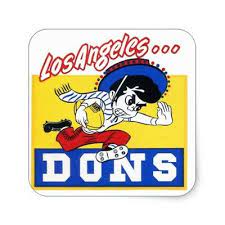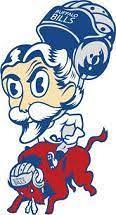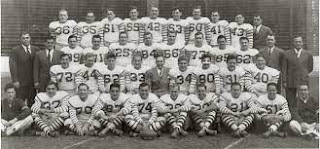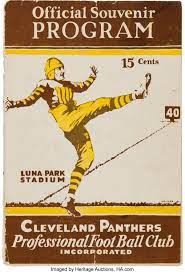Card-Pitt was the team created by the temporary merger of two National Football League (NFL) teams, the Pittsburgh Steelers and the Chicago Cardinals, during the 1944 season. It was the second such merger for the Steelers, who had combined with the Philadelphia Eagles in 1943 to form the "Steagles". The arrangement was made necessary by the loss of numerous players to World War II military service, and was dissolved upon completion of the season. The war ended before the start of the 1945 season, and both teams resumed normal operations. Card-Pitt finished with a 0–10 record in the Western Division, which led sportswriters to derisively label the team the "Car-Pitts", or "carpets".
The Boston Yanks joined the NFL in 1944, while the Cleveland Rams, who had been unable to field a team in 1943, re-joined the league. This resulted in an 11-team league, and the NFL was unable to devise a schedule that was amenable to all registered teams. NFL commissioner Elmer Layden contacted Art Rooney and Bert Bell of the Steelers to request that their team again merge as a potential solution for the scheduling issue. Rooney agreed, on the condition that at least half of the team's home games would be played at Pittsburgh's Forbes Field.
The choice of a merger partner for the Steelers proved to be a challenging task. Rumors prior to the NFL's annual April meeting indicated that either Cleveland or the Brooklyn Tigers would be the selected partner. Cleveland was considered a logical choice based solely on geographic location, but Layden felt it unfair to ask the Steelers to merge with a team that had been defunct a year earlier. Rooney rejected a proposal to merge with Brooklyn, and was hesitant to merge with the new Boston Yanks. He eventually agreed to combine his Steelers with the Cardinals, who had gone winless in 1943 along with having lost 16 straight games since their last win on October 18, 1942. The merged team would compete in the tougher Western Division, which included the Green Bay Packers and Chicago Bears.
Training camp for the merged team began in Waukesha, Wisconsin on August 15, 1944, under the direction of co-coaches Walt Kiesling of Pittsburgh and Phil Handler of Chicago. The coaching staff decided before the start of camp to implement a T formation offense. Some of the Steelers' players had been exposed to the 'T' with playing alongside Philadelphia Eagles players the previous year, but the Cardinals had used it very little. Card-Pitt lacked a dependable quarterback, but the team began the season with optimism.
During the team's first game, an exhibition at Shibe Park against the Philadelphia Eagles, that was attended by Babe Ruth, the Eagles scored three first-quarter touchdowns on their way to a 22–0 victory. Card-Pitt regained its footing the following week, but lost 3–0 to a Washington Redskins team that had been predicted to win the game by three touchdowns.
Training camp for the merged team began in Waukesha, Wisconsin on August 15, 1944, under the direction of co-coaches Walt Kiesling of Pittsburgh and Phil Handler of Chicago. The coaching staff decided before the start of camp to implement a T formation offense. Some of the Steelers' players had been exposed to the 'T' with playing alongside Philadelphia Eagles players the previous year, but the Cardinals had used it very little. Card-Pitt lacked a dependable quarterback, but the team began the season with optimism.
During the team's first game, an exhibition at Shibe Park against the Philadelphia Eagles, that was attended by Babe Ruth, the Eagles scored three first-quarter touchdowns on their way to a 22–0 victory. Card-Pitt regained its footing the following week, but lost 3–0 to a Washington Redskins team that had been predicted to win the game by three touchdowns.
Quarterback Coley McDonough was drafted into the U.S. Army two days before the team's second regular season game, a contest against Green Bay. The Pittsburgh Press gave the team little chance to defeat the Packers, who would go on to win that game 34–7. However, John McCarthy, a rookie out of Saint Francis University in Loretto, Pennsylvania, performed well as McDonough's replacement.
Card-Pitt then met the Chicago Bears, a team missing MVP quarterback Sid Luckman and coach George Halas among a roster that had been depleted by the war and injuries, in the third game of the season. The Pittsburgh Post-Gazette called Card-Pitt's effort against the Bears "pitiful", and the coaching staff became so irate that they fined Johnny Butler, John Grigas and Eberle Schultz $200 apiece for "indifferent play". Upset with the coaches' strict, dictatorial style, the team refused to practice until the fined players received a fair hearing. The players then met with Rooney, and Grigas and Schultz agreed to pay their fines and return to practice. Butler was suspended indefinitely, before being placed on waivers and later claimed by Brooklyn. Rooney eventually rescinded the fines, except for Butler's.
Pittsburgh Post-Gazette sports editor Al Abrams then quoted a disgusted fan as having written, "Why don't they call themselves the Car-Pits? I think it's very appropriate as every team in the league walks over them." The team lost a rematch against the Giants. Midway through their next game against the Washington Redskins, a brawl between the two teams erupted and had to be broken up by police. Coaches Kiesling and Handler were in the middle of the fight, while Rooney, a former boxer, ran to join his team, until he realized that it would be a breach of protocol for an NFL owner to get into a fight with opposing players. The Redskins would go on to win the game, 42–20. Card-Pitt's Cliff Duggan was fined $200 for his role in the fight, however, Rooney paid his fine.
Losses then ensued against the Rams, Packers and Lions, and Grigas left the team to return home to Massachusetts. He had twice won the league rushing title, but had grown tired of losing and retired. Despite his sudden departure, he was named to the New York Daily News All-Pro team, and finished the season with 610 yards rushing, an average of 3.3 yards per carry. His departure was followed by a 49–7 loss to the Bears. The team's 0–10 season tied the Brooklyn Tigers for the league's worst record. The merger of the Chicago Cardinals and the Pittsburgh Steelers was dissolved the day after the season ended. Only five teams since 1944 have gone winless in the NFL for an entire season: the 1960 Dallas Cowboys (0–11–1), the 1976 Tampa Bay Buccaneers (0–14), the (strike shortened) 1982 Baltimore Colts (0–8–1), the 2008 Detroit Lions (0–16) and the 2017 Cleveland Browns (0-16).
The Card-Pitt punters averaged 32.7 yards per attempt, which is still the worst mark in NFL history. The team was 0–2 in field goal attempts, while Conway Baker missed four of his 15 extra point tries.
Card-Pitt passers had a 31% completion rate, and threw for just eight touchdowns; their total of 41 interceptions is still the third highest number in NFL history, even more remarkable given the season was incrementally lengthened to 12, 14, 16, and currently 17 games (the 1944 season had 10). McCarthy threw 13 interceptions, had no touchdown passes, and finished with a quarterback rating of 3.0.
Card-Pitt also had the worst run defense in the league, and were outscored 328–108 by opponents.
Eberle Schultz went from a winless 1944 season to an NFL Championship with Cleveland the following year. John Grigas returned to the NFL for three final seasons with the Boston Yanks, and led the team in rushing in 1946. Don Currivan played alongside Grigas for those three seasons, and ranked third in the league in receiving in 1947, and Currivan also saw played with the Los Angeles Rams, being part of the team that lost to Philadelphia in the 1949 NFL Championship Game.
Tackle Chet Bulger and center Vince Banonis would be a part of the 1947 Chicago Cardinals Championship team, while Banonis also played for the Detroit Lions, winning League Championships in 1952 and 1953 (on teams coached by Card-Pitt assistant coach Buddy Parker).
The Cardinals did not win a game again until October 14, 1945 (nearly three years to the day of their last win), when they beat the Chicago Bears 23-14: while it was the Cardinals' only win of the 1945 season, this also ended a 29-game losing streak. This is an NFL record but some people don't count all 29 losses since the team merged in 1944 with Pittsburgh. The Steelers, who had won their last game on November 28, 1943, ended a 14-game losing streak on October 21, 1945, beating the New York Giants 21-7.
In 1947, both teams rose to the top of the league: the Cardinals finished 9-3, beating the Bears in their last game to win the Western Division, their first title since 1925, while the Steelers finished tied with the Eagles for the Eastern Division. The Steelers lost a one-game playoff to the Eagles 21–0 in driving snow and rain, and the following week, the Championship Game saw the Cardinals beat the Eagles 28–21 to win their second NFL Championship (and most recent as of 2021).
In 2009, 65 years after merging for a season, the Steelers and the Cardinals (by then based in Glendale, Arizona) played each other in Super Bowl XLIII.
Sources
https://www.pro-football-reference.com/
https://www.profootballarchives.com/index.html
https://americanfootballdatabase.fandom.com/wiki/Football_Wiki
https://www.gridiron-uniforms.com/GUD/controller/controller.php?action=main
https://www.profootballhof.com/hall-of-famers/
Roberts, R. and Welky, D. (Eds.), "The Steelers Reader." University of Pittsburgh Press, 2001, p.61.
Kiss Em Goodbye: An ESPN Treasury of failed, forgotten, and departed teams, pp.67–68, Dennis Purdy, Ballantine Books, New York, 2010, ISBN 978-0-345-52012-8
2005 Saint Francis University, Loretto, Pennsylvania Alumni Directory page 307 Class of 1942
Algeo, Matthew, "Last Team Standing: How the Steelers and the Eagles--'The Steagles'--Saved Pro Football during World War II." Cambridge, MA: Da Capo Press, 2006, p. 207–208.
Abrams, Al (October 20, 1944). "Sidelights on Sports". Pittsburgh Post-Gazette. p. 15.
Kiss Em Goodbye: An ESPN Treasury of failed, forgotten, and departed teams, p.69, Dennis Purdy, Ballantine Books, New York, 2010, ISBN 978-0-345-52012-8
Forr, James (2003). "Card-Pitt: The Carpits" (PDF). Coffin Corner. 25 (3). Professional Football Researchers Association: 1–8.
























